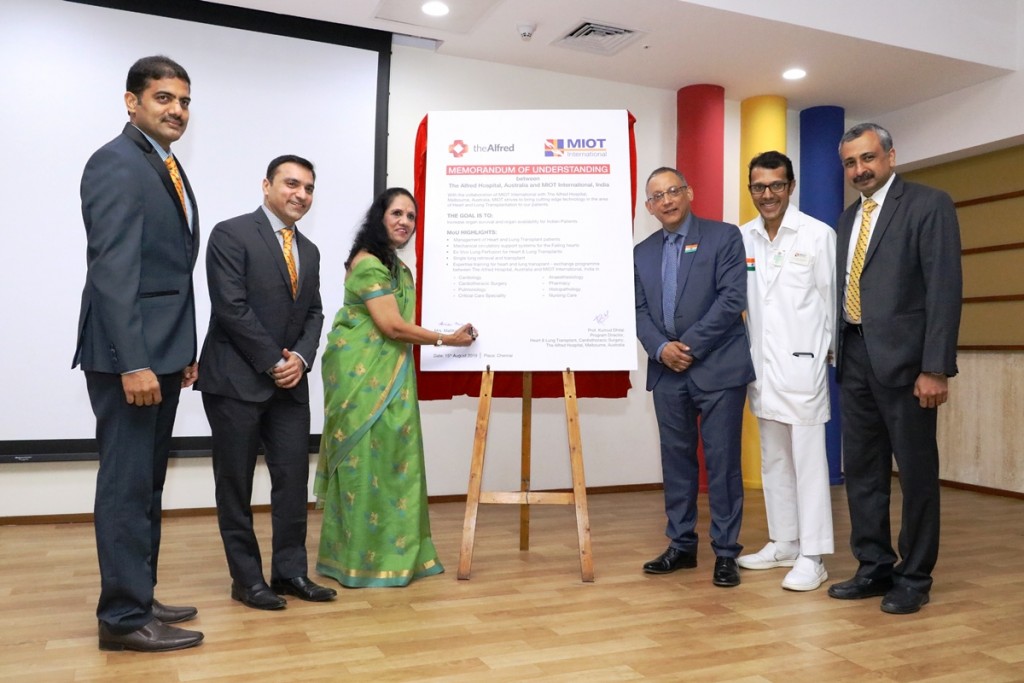Past events at MIOT
MIOT International Signs MoU With Leading Transplant Centre In Australia
Heart failure is the major cause of death around the world. In India, it is more common among the younger generation when compared to many other countries.

Photograph seen from left to right: Dr. Manimaran M, Pulmonologist & Allergist, MIOT International, Dr. Prakash M Ludhani, Cardiothoracic & Transplant (Heart, Lung) Surgeon, MIOT International, Mrs. Mallika Mohandas, Chairman, MIOT International, Prof. Kumud Dhital, Professor of Cardiothoracic Surgery and Director – Alfred Heart & Lung Transplant Program, The Alfred Hospital, Melbourne, Australia, Dr. Prithvi Mohandas, Managing Director, MIOT International, Dr. Vijit K. Cherian, Director, Adult Cardiothoracic Surgery, MIOT International.
Heart and lung transplant surgery has come a long way to provide the much-needed solution to end-stage organ failure. Over the past decade, the survival rate of patients undergoing heart and lung transplant has improved significantly due to advances in immunosuppression drugs, basic research and aggressive donor organ retrievals.
The areas of temporary mechanical circulatory support systems, which have witnessed vast improvement, are now available in our country too. But, access to a matching donor heart for the patient who needs early heart transplant continues to be a challenge. Their blood groups, age of the donor, the suitability of a heart without any other diseases, care of the brain-dead donor in a short span of time, all determine good outcomes in this challenging surgery.
In heart transplant, the limitation of four hours to transport and implant the donor heart limits the availability of many suitable donor organs. This is particularly seen in countries with vast geographical areas like the USA, Australia and India.
Prof. Kumud Dhital
Prof. Kumud Dhital, Professor of Cardiothoracic Surgery and Director – Alfred Heart & Lung Transplant Program, The Alfred Hospital, Melbourne, Australia, is a world renowned, leading heart and lung transplant surgeon. He is a pioneer and researcher in the area of organ care system for the heart. Prof. Dhital performed the first Organ Care System-supported Heart Transplant in the world in 2014. Since then, he has performed close to forty such transplants.
Prof. Dhital has made major contributions to Heart and Lung Transplant in the UK and Australia. Prior to his present position, he was Associate Professor at St. Vincent’s Hospital, Sydney, Australia, which has been the leading Heart and Lung Transplant centre over the years.
The availability of organ care system for Heart Transplant enhances the possibilities of more donor hearts being available to a patient needing heart transplant. The donor heart retrieved from a donor is attached to a machine which allows continuous circulation to the heart, thereby making it beat during transportation. This allows the donor heart to be transported across long distances, and ensures the availability of more hearts.
In the conventional way of transporting a heart, a solution is perfused to the organ to preserve it, and is transported as a ‘still heart’ in an ice box. The conventional technique allows only up to four hours for implantation. The lesser the transportation time, the better the results of a successful heart transplant.
Advantages of organ care system (OCS)
- Availability of hearts which were unstable and earlier refused
- Possibility of longer transportation time for heart retrieval
- Allows to travel long distances to retrieve the heart
- It is possible to monitor the status of the organ from harvest to transplant
EX VIVO LUNG PERFUSION (EVLP)
It’s an innovative technique designed to keep the pair of lungs ‘alive’ outside the donor’s body before the lung transplant procedure. This method of evaluating and preserving a pair of lungs will ensure that more patients will be able to undergo a lung transplant.
In the conventional method, after retrieval, donor lungs are usually kept in an organ-preserving solution, and transported in an ice box. The maximum acceptable time before transplant is 6 to 8 hours. With ex vivo perfusion, this duration can be doubled, which will enable more lung transplants to be performed with greater flexibility.
In this technique, lungs are maintained at a normal body temperature and treated with a bloodless solution that contains nutrients, proteins and oxygen. This can reverse lung injury and removes excess lung water. During the process, lung function is evaluated continuously. Once determined to be suitable, the lungs are ready for transplant.
Also, in the conventional method, donor lungs can be unsuitable for transplant because of poor viability and quality. Those lungs can be treated with this EVLP method for 3 to 4 hours and can be used for transplantation. This process takes 3 to 4 hours during which the donated lungs are placed inside a sterile plastic dome attached to a ventilator, pump and filters. It’s very useful in increasing the donor pool, so that more patients are benefitted.
EVLP is offered only by a handful of centres, which are limited to countries like the USA, Canada and Australia.
MIOT’s pulmonologists underwent this unique lung transplantation training in Australia, under the guidance of Prof. Kumud Dhital. Observing these newer techniques motivated them to bring it to MIOT International, which would highly benefit Indian patients who are waiting for a lung transplant.
MEMORANDUM OF UNDERSTANDING between MIOT International, India and The Alfred Hospital, Australia |
|
|---|---|
With the collaboration of MIOT International with The Alfred Hospital Melbourne, Australia, MIOT strives to bring cutting edge technology in the area of Heart and Lung Transplantation to our patients.
THE GOAL IS TO:Increase organ survival and organ availability for Indian Patients MOU Highlights:
|
|



